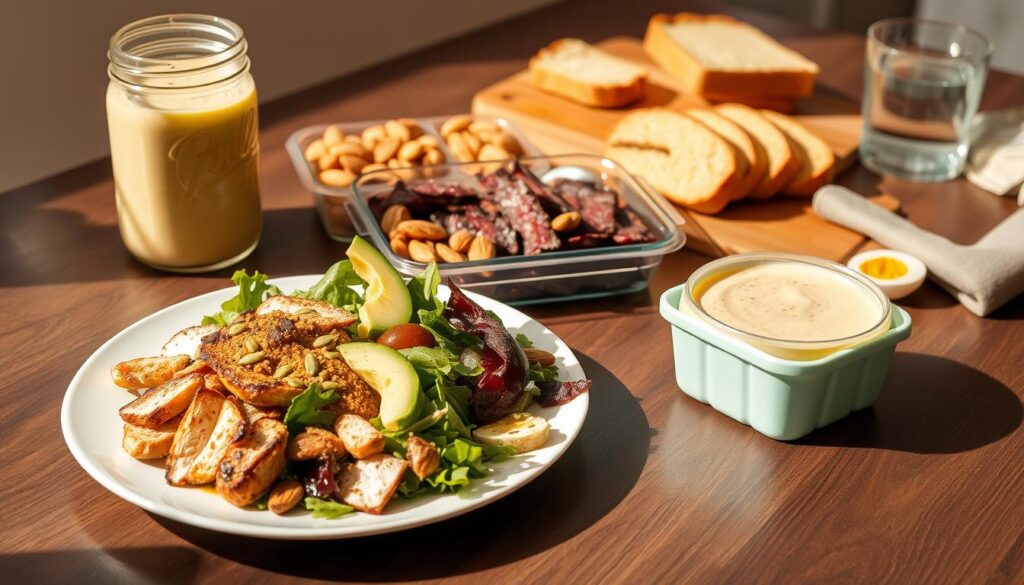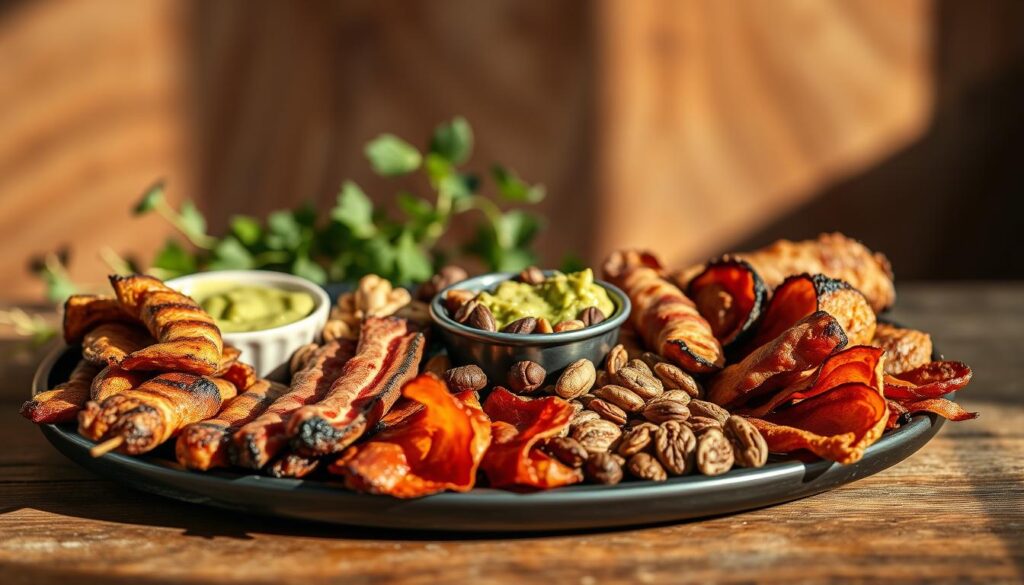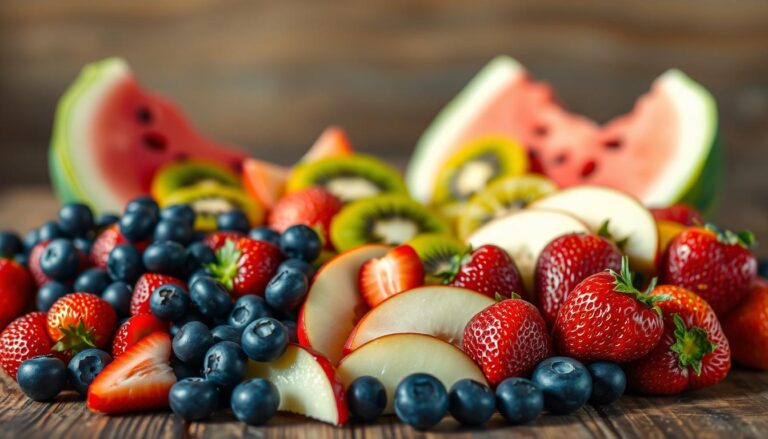Carnivore Diet Recipes: Fuel Your Body with Protein
Embracing a meat-based diet can be a transformative experience, offering numerous health benefits and a boost in energy levels. The carnivore diet, focusing on protein-rich recipes, has gained popularity for its simplicity and effectiveness.
By incorporating a variety of meats into your meals, you can fuel your body with the necessary proteins to support muscle growth and overall well-being. This approach to eating not only simplifies meal planning but also provides a satisfying and filling way to nourish your body.
Key Takeaways
- Meat-based diets can boost energy levels and support overall health.
- Protein-rich recipes are essential for muscle growth and well-being.
- A carnivore diet simplifies meal planning and provides a satisfying way to eat.
- Incorporating variety in your meat-based meals can enhance nutritional benefits.
- Focusing on whole, unprocessed meats is key to a successful carnivore diet.
What Is the Carnivore Diet?
The carnivore diet, also known as the zero-carb diet or all-meat diet, is an eating plan that consists entirely of animal products. This dietary approach has garnered significant attention for its simplicity and potential health benefits.
Core Principles and Food List
The core principle of the carnivore diet is to consume only foods of animal origin. This includes:
- Meat (beef, pork, lamb, etc.)
- Fish and seafood
- Organ meats (liver, kidney, etc.)
- Eggs
- Animal-based fats (tallow, lard, etc.)
- Dairy (optional, as some versions of the diet exclude it)
Foods to avoid include all plant-based foods such as fruits, vegetables, grains, and legumes.
Health Benefits and Potential Considerations
Proponents of the carnivore diet report several health benefits, including weight loss, improved mental clarity, and reduced inflammation. However, potential considerations include the diet’s restrictive nature and the need to ensure adequate nutrient intake.
| Benefit | Description |
|---|---|
| Weight Loss | Many individuals report significant weight loss on the carnivore diet. |
| Improved Mental Clarity | Some followers of the diet note improved cognitive function. |
| Reduced Inflammation | The diet’s focus on animal products may help reduce body inflammation. |
Who Thrives on a Carnivore Approach
Individuals who may thrive on the carnivore diet include those with certain dietary restrictions or preferences, such as those with severe digestive issues or those looking for a straightforward dietary regimen.
In conclusion, the carnivore diet is a unique dietary approach that focuses on consuming only animal products. While it may offer several health benefits, it’s essential to consider the potential challenges and ensure it aligns with your nutritional needs.
Essential Ingredients for Your Carnivore Kitchen
The carnivore diet’s effectiveness is largely dependent on the quality and variety of its core ingredients. A well-stocked carnivore kitchen is the foundation upon which successful meals are built.
To start, it’s crucial to understand the types of ingredients that are central to this diet. The primary components include premium meats, organ meats, and animal-based fats, all of which provide the necessary nutrients for optimal health.
Premium Meat Selections and Sourcing
Premium meat selections form the backbone of the carnivore diet. When sourcing meat, it’s advisable to opt for grass-fed beef, pasture-raised poultry, and wild-caught fish. These options are not only richer in nutrients but also lower in unhealthy additives.
Some of the best premium meat selections include:
- Ribeye steaks
- Sirloin steaks
- Ground beef
- Chicken breasts
- Salmon fillets
Organ Meats and Their Nutritional Powerhouse Status
Organ meats are a nutritional cornerstone of the carnivore diet, offering a dense source of vitamins and minerals. Liver, kidneys, and heart are among the most beneficial organ meats, rich in iron, vitamin A, and other essential nutrients.
| Organ Meat | Nutritional Highlights |
|---|---|
| Liver | Rich in iron and vitamin A |
| Kidneys | High in vitamin B12 and selenium |
| Heart | Excellent source of CoQ10 and iron |
Animal-Based Fats, Eggs, and Permitted Seasonings
Animal-based fats are another critical component, serving as a primary energy source. Tallow and lard are excellent choices for cooking, while eggs provide a versatile and nutrient-rich food option.
When it comes to seasonings, the carnivore diet advocates for minimalism, recommending sea salt and black pepper as the primary seasonings.
Delicious Carnivore Diet Recipes for Breakfast
The carnivore diet offers a variety of delicious breakfast options that are rich in protein. These recipes are designed to kick-start your day with the nutrients you need.
Ribeye and Eggs Breakfast Bowl
A ribeye steak paired with eggs is a classic carnivore breakfast. Season the ribeye with salt and sear it in a hot pan to achieve a perfect crust. Serve with eggs cooked to your preference.
Tips: Use pasture-raised eggs for better nutritional content, and choose grass-fed ribeye for its superior flavor and health benefits.
Bacon-Wrapped Liver Medallions
Liver is a nutrient-dense organ meat that’s perfect for breakfast. Wrapping it in bacon adds a smoky flavor that complements the liver’s richness.
- Slice liver into medallions
- Wrap each medallion with a slice of bacon
- Pan-fry until the bacon is crispy
Carnivore Breakfast Casserole
This casserole is a hearty breakfast option that combines various meats. It’s ideal for meal prep or feeding a crowd.
- Layer ground beef, sausage, and bacon in a baking dish
- Add eggs on top
- Bake until the eggs are set
Preparation Tips
When preparing carnivore breakfasts, focus on using high-quality meats. Grass-fed beef and pasture-raised eggs offer better nutritional profiles.
Variations for Different Tastes
To add variety, try different seasonings or types of meat. For example, using lamb instead of beef can give a unique flavor to your breakfast dishes.
“The carnivore diet is not just about eating meat; it’s about embracing a lifestyle that focuses on nutrient-dense foods.”
Protein-Packed Lunch Recipes
Elevate your lunchtime with these carnivore diet recipes that are not only delicious but also packed with protein. Maintaining a diet rich in protein is essential for muscle repair, energy, and overall health. Here are some mouth-watering ideas to keep you fueled throughout the day.
Bunless Burger Stacks
A classic carnivore favorite, bunless burger stacks are easy to make and can be customized with your favorite toppings. Simply grill or pan-fry a beef patty, top it with cheese, bacon, or a fried egg, and you’re good to go.
Cold Roast Beef Roll-Ups
Cold roast beef roll-ups are a convenient and protein-rich option for lunch. Simply slice cold roast beef thinly, add some cheese or a dollop of carnivore-friendly sauce, and roll them up. They’re perfect for a quick, satisfying meal on the go.
Bone Broth and Shredded Chicken
For a lighter yet still protein-packed option, consider a bowl of bone broth with shredded chicken. This meal is not only nourishing but also easy to reheat at work.
Portable Packaging Ideas
To keep your meals fresh and organized, consider using reusable containers or bags that are easy to clean and durable. This not only helps in maintaining the quality of your meal but also supports an eco-friendly lifestyle.
Workplace Reheating Strategies
If you have access to a microwave at work, reheating your meal is straightforward. For bone broth and shredded chicken, simply heat it for a minute or two until it’s steaming hot. For other recipes like bunless burgers, consider using an electric lunch box that can heat your meal evenly.

| Recipe | Protein Content | Preparation Time |
|---|---|---|
| Bunless Burger Stacks | 35g | 15 minutes |
| Cold Roast Beef Roll-Ups | 30g | 10 minutes |
| Bone Broth and Shredded Chicken | 25g | 5 minutes |
These protein-packed lunch recipes are designed to be easy to prepare, delicious, and satisfying, making it easier to stick to your carnivore diet. Whether you’re at home or on the go, these meals will keep you energized and focused.
Hearty Carnivore Dinner Options
Hearty dinners are a staple of the carnivore diet, offering a range of delicious options that are both satisfying and packed with protein.
Perfect Ribeye Steak Method
A perfectly cooked ribeye steak is a dinner staple for many on the carnivore diet. To achieve this, start by bringing the steak to room temperature. Season generously with salt. Heat a skillet over high heat, add a small amount of animal-based fat, and sear the steak for 2-3 minutes on each side. Finish in the oven at 400°F (200°C) to your desired doneness. Let it rest before serving.
Slow-Cooked Beef Short Ribs
Slow-cooked beef short ribs are a comforting dinner option that falls off the bone. Season the ribs with salt. Heat a Dutch oven over medium-high heat, sear the ribs on all sides, then set them aside. Sauté some onions until they’re softened, then add the ribs back in, cover with a lid, and slow cook in the oven at 300°F (150°C) for about 2.5 hours, or until tender.
“The key to a great carnivore dinner is using high-quality ingredients and cooking them in a way that enhances their natural flavors.”
Butter-Basted Lamb Chops
Butter-basted lamb chops offer a rich and indulgent dinner. Season the lamb chops with salt. Heat a skillet over medium-high heat, add the lamb chops, and sear until browned on both sides. Reduce the heat to medium, add a generous amount of butter, and baste the lamb chops continuously until they’re cooked to your liking. Serve immediately.
Wild-Caught Salmon with Tallow
For those who include fish in their carnivore diet, wild-caught salmon cooked with tallow is a delicious option. Season the salmon fillet with salt. Heat a skillet over medium heat, add some tallow, and cook the salmon skin-side down until crispy. Flip and cook the other side until done. The result is a crispy-skinned, tender salmon fillet.
| Dinner Recipe | Cooking Method | Key Ingredients |
|---|---|---|
| Perfect Ribeye Steak | Sear and oven finish | Ribeye, salt, animal fat |
| Slow-Cooked Beef Short Ribs | Slow cooking | Beef short ribs, onions, salt |
| Butter-Basted Lamb Chops | Sear and baste | Lamb chops, butter, salt |
| Wild-Caught Salmon with Tallow | Pan-sear | Salmon, tallow, salt |
Carnivore Diet Recipes for Snacks and Appetizers
Indulge in the rich flavors of the carnivore diet with these irresistible snack and appetizer recipes. Snacking is an essential part of our daily routine, and with these carnivore diet recipes, you can enjoy delicious and healthy options. From homemade pemmican bars to deviled eggs with bacon crumbles, these recipes are perfect for any occasion.
Homemade Pemmican Bars
Pemmican bars are a traditional snack made from animal fat and protein-rich ingredients. To make them, you’ll need:
- 1 cup beef tallow
- 1/2 cup dried meat (beef or venison)
- 1/4 cup chopped nuts (optional)
Mix the ingredients together, pour into a lined baking dish, and refrigerate until set. Cut into bars and enjoy.

Crispy Chicken Skin Chips
Crispy chicken skin chips are a tasty snack. To make them:
- Preheat your oven to 400°F (200°C).
- Lay chicken skins on a baking sheet lined with parchment paper.
- Bake until crispy, then season with salt.
These make a great crunchy snack.
Beef Jerky Three Ways
Beef jerky is a convenient snack. Here are three ways to make it:
- Teriyaki: Marinate in a mixture of soy sauce, garlic, and ginger.
- Spicy: Add chili flakes to your marinade.
- Smoky: Use liquid smoke in your marinade.
Marinate thinly sliced beef in your chosen flavor, then dry in a dehydrator or oven on the lowest temperature setting.
Deviled Eggs with Bacon Crumbles
Deviled eggs are a classic snack. To make them carnivore-friendly:
- Hard-boil eggs, cool, then cut in half lengthwise.
- Remove yolks and mix with mayonnaise, mustard, and diced bacon.
- Fill egg whites with the yolk mixture and top with crumbled bacon.
These are perfect for a protein-packed snack.
| Snack Recipe | Prep Time | Protein Content |
|---|---|---|
| Homemade Pemmican Bars | 10 minutes | High |
| Crispy Chicken Skin Chips | 20 minutes | Medium |
| Beef Jerky | 30 minutes | High |
| Deviled Eggs with Bacon | 15 minutes | Medium |
Meal Planning and Prep Strategies
To thrive on a carnivore diet, mastering meal prep strategies is essential. This approach not only simplifies your daily routine but also ensures you’re getting the most out of your diet.
Weekly Carnivore Shopping Guide
Creating a weekly shopping guide is the first step towards efficient meal planning. Focus on purchasing a variety of meats, including organ meats and animal-based fats. Consider buying in bulk to save money and reduce waste.
- Ribeye steaks
- Ground beef
- Chicken thighs
- Pork sausages
- Organ meats (liver, kidney)
Batch Cooking Techniques for Busy People
Batch cooking is a lifesaver for those with busy schedules. By cooking large batches of meat at once, you can save time during the week and ensure you always have a healthy meal ready.
Batch Cooking Tips:
- Cook multiple steaks at once
- Use a slow cooker for tender meats
- Prepare individual portions for easy reheating
Storage Solutions for Optimal Freshness
Proper storage is crucial for maintaining the freshness and quality of your meat. Invest in airtight containers and consider vacuum sealing for longer storage.
| Storage Method | Best For | Duration |
|---|---|---|
| Airtight Containers | Short-term storage | 3-5 days |
| Vacuum Sealing | Long-term storage | Several months |
Budget-Friendly Carnivore Eating
Eating carnivore doesn’t have to break the bank. By buying in bulk, choosing cheaper cuts of meat, and planning your meals, you can enjoy the benefits of a carnivore diet on a budget.
Budget Tip: Consider purchasing lesser-known cuts of meat, which are often cheaper but just as nutritious.
Adapting to the Carnivore Lifestyle
For those considering a carnivore lifestyle, understanding the practical aspects is crucial for long-term success. This dietary approach, centered around consuming animal-based foods, requires adjustments in various aspects of daily life, from grocery shopping to dining out.
Transitioning from Standard American Diet
Transitioning from a standard American diet to a carnivore diet can be challenging due to the significant reduction in carbohydrate intake and the elimination of plant-based foods. Start by gradually increasing your consumption of animal products while reducing your intake of sugars and grains. This gradual adjustment can help minimize potential side effects and make the transition smoother.
Overcoming Common Challenges
One of the common challenges faced by individuals adopting a carnivore lifestyle is dealing with social pressures and misconceptions about the diet. Educating friends and family about your dietary choices can help in gaining their support. Additionally, connecting with like-minded communities online can provide valuable resources and encouragement.
Dining Out While Staying Carnivore
Dining out while adhering to a carnivore diet can be manageable with the right strategies. Opt for restaurants that serve high-quality meats and don’t hesitate to ask for modifications to fit your dietary needs. For instance, ordering a steak without the vegetable side dish or choosing a burger without the bun are simple ways to stay on track.
Tracking Progress and Adjusting Your Approach
Monitoring your health and adjusting your carnivore diet as needed is crucial. Keep a food diary to track your intake and any changes in your health. Regularly assessing your energy levels, digestive health, and overall well-being can help you fine-tune your diet for optimal results.
Conclusion: Thriving with Protein-Focused Eating
Adopting a carnivore diet can be a transformative experience, offering a sustainable and thriving approach to nutrition. By focusing on protein-rich foods and eliminating plant-based ingredients, individuals can potentially improve their overall health and well-being.
The carnivore diet recipes and meal planning strategies outlined in this article provide a solid foundation for those looking to make the transition. From hearty breakfast dishes to satisfying dinner options, the variety of carnivore diet recipes ensures that there’s something for everyone.
As you embark on your carnivore journey, remember to prioritize premium meat selections, organ meats, and animal-based fats. By doing so, you’ll be well on your way to thriving with protein-focused eating and enjoying the many benefits that this approach has to offer.








One Comment